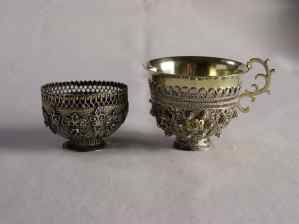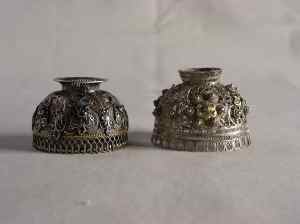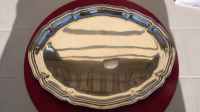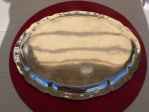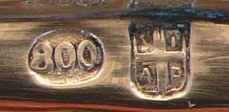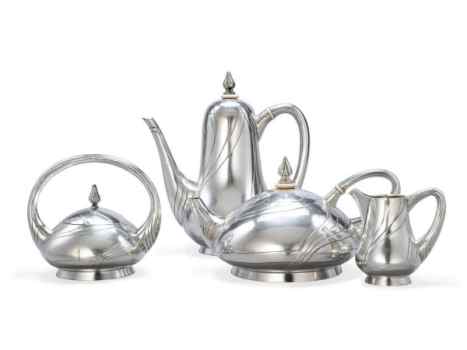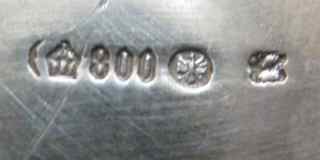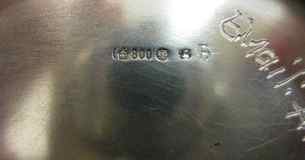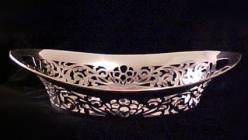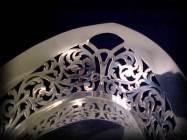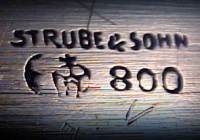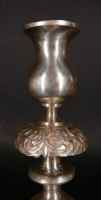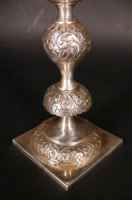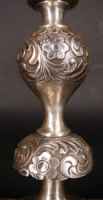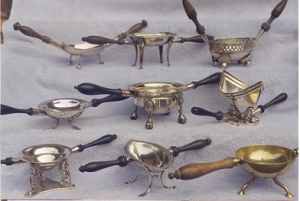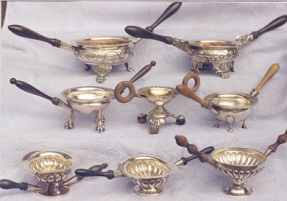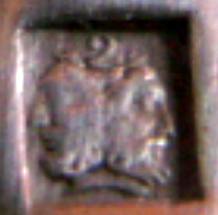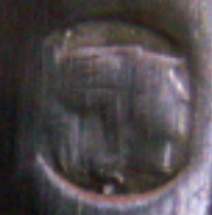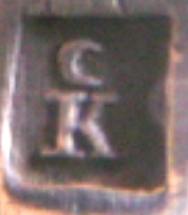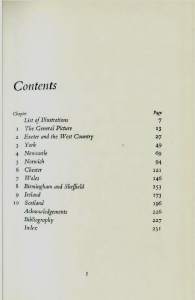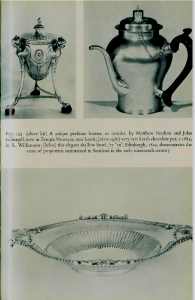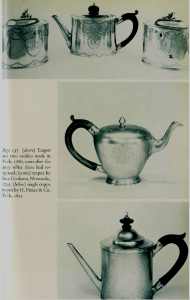| |
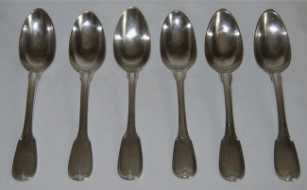
Giovanni Ciceri presents:
A FRENCH CANTEEN (Part) - Paris 1764/1819 -

In this article we present a part of a French canteen
composed of pieces of various age and makers. Most
pieces were manufactured and hallmarked in Paris between
1762 and 1819. The prevalent pattern is the so called
fiddle thread, very popular in France from the mid of
18th century....
click here

|
| |
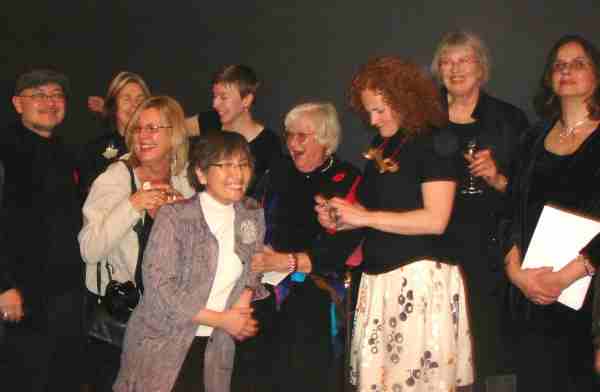
Dorothea Burstyn presents
Celebration, News from the Canadian Metal Arts Scene

... Celebration, The Legacy of Lois Etherington
Betteridge, was an exhibition at Jonathon's Bancroft
Snell Gallery in downtown London, Ontario, from November
6 - 16, 2008. It was meant to celebrate Lois' 80th
birthday, but rather than choosing the format of a solo
exhibition or retrospective of her work Lois Betteridge
wanted Celebration to be a group exhibition of
her work and those of selected students. While there are
of course many metal artists active at work in Canada,
Celebration served as an introduction to "Who is
who" on the modern Canadian metal arts scene. Jonathon
Bancroft Snell has made a name for himself and his
gallery, being an excellent promoter of modern Canadian
ceramics and it is to be hoped that he will do the same
for metal artists signed up with his gallery.......
click here

|
Welcome to new ASCAS members:
Andrew Brasch - USA
Marina Ciarlo' - Malta
Jackie Craig - England UK
George Fritz - USA
Laurence Joyce - England UK
Konstantin Kunstanovich - USA
Craig Rayner - Australia
Adam Thomson - USA
Members' Window # 58
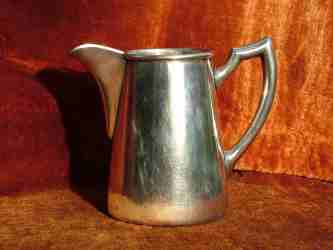
Prof. David N. Nikogosyan presents:
Marks of European Silver Plate: III. Bohrmann,
Hartmann & Hepp, Germany

In the current Member's Window, I am continuing the
discussion of marks issued by the continental producers
of silver plate active during the Art Nouveau period.
This time I will present three rather unknown German
companies (in comparison with the well-documented
Wuerttemberg Metalware Factory or WMF and the renowned
August Wellner & Sons Factory in Aue, Saxony).
In 2000 at the antique market "Izmailovo", Moscow,
Russia, I acquired my first item of Bohrmann silver
plate, a large milk can, for 15 US $. It was freezing
cold (-25° C) and was difficult to use a lens, which was
immediately covered by frost, originating from my breath,
nevertheless, I managed to read the mark and was
surprised to find that besides the name of a maker, it
contained the place and the year (!) of production.....
click here

|
Kari Helenius writes:
...Following the "Dictionary" published in February Newsletter I
attach images of two zarfs. The other one has been equipped with
a charka inside. The charka which seems to have been made
especially for this purpose and it is attached to the zarf with
a soldered screw which goes through the zarfs bottom where there
is a nut below. The charka is marked in Moscow 1791.
I thought that this might interest you.
Best regards
Kari
Mario Galasso writes:
... I bought an ancient silver tray marked "800" and a mark
unknown to me. I believe it is Italian, before 1935. The mark on
the left is a shield with SIAP and a sort of cross inside.
Do you have any idea about the maker?
Thanks for your help
Mario Galasso
The maker of your tray is S.I.A.P. Società Argenterie
Posaterie già Barberis - Pietrasanta & C - Alessandria. The firm
is listed in the 1924 "Annuario Generale Ufficiale Orefici
Argentieri ed Affini"
Another source quotes that in 1919 "Barberis, Pietrasanta e C.
fabbricante di argenterie" transferred its premises at the
corner of Palermo and Pacinotti St. in Alessandria, where they
began to build a new factory.
In 1920 was founded SIAP (Società Industriale Argenterie
Posaterie) that used and enlarged the factory built by Barberis,
Pietrasanta e C.
In 1936 part of the building used by SIAP was bought by IMA
GuercP (another firm active in silverware production).
Therefore, a reliable hypothesis is that SIAP was active between
1920 and 1936.
Giorgio Busetto
Adam Thomson writes:
... I have been unable to determine which craftsman/designer by
name made this silver. I believe it is either a German or
Belgian Art Nouveau tea set. Kevin Tierney from Sotheby's told
me he thought it was from P. Bruckmann und Söhne of Germany. It
might have been designed by Henry Van de Velde, if only because
the sugar bowl has his kind of designer lines used on it. I
bought it 30 years ago at auction at Sotheby's (NY) and, even
after researched it in the Library of Congress, I don't know the
craftsman / silversmith who made it.
Here are the makers that I believe worked for that silver
manufacturer around 1900 that might have made it.
Clicking on this link you may see a detailed list of German
architects, designers and silversmiths that worked for Bruckmann
& Sohne and Henry van de Velde.
I will include pictures of the silver set and its hallmarks
attached. Any assistance helping me to identify the last one or
two stamped hallmarks its maker would be appreciated. The second
to last hallmark stamp on the far right hand side looks a bit
like it was made by Posen, but that name is not stamped on the
piece.
I would like to get up with any people that you consider are
German Art Nouveau silver experts that could help me identify
this fine silver tea service. If any members know how to contact
a Dr. Helmut Reuter of the Henry van de Velde Gesellschaft in
Hagen, Germany or Anneliese Krekel-Aalberse in Europe let me
know how to do so.
Kindest Regards
Adam Thomson
email: thomsonsemail@yahoo.com
Replies to questions
Kelli Rooney
receives this reply about her silver fruit basket
(see February Newsletter)
Charles C. Cage writes:
...Regarding Kelli Rooney’s question about Strube &
Son, the firm was active in Leipzig, Germany from 1819
until WWII. Although the firm did manufacture silver in
the 19th century, by the time this piece was made (1st
quarter, 20th century, I’d estimate) they were primarily
luxury retailers.
Charles C. Cage
Dariusz Malinowski receives this reply about his
silver candlestick
(see February Newsletter)
Charles C. Cage writes:
...Regarding Dariusz Malinowski’s Russian
candlestick, it is actually Polish, from the
city of Warsaw when it was under Russian
jurisdiction, 1852-1915. The mark on the far
right -the Russian Imperial eagle- is the Warsaw
city mark. "84" is the fineness of 84 zolotniks:
84/96 or .875. The assayer "WK" is Walery
Kostrebski, working in Warsaw 1852-1860. The
maker "Szkarlat" is Szmul Szkarlat, working ca.
1860-1904; the mark next to his - a ewer - is
his trademark.
Charles C. Cage
Adam Goldsmith writes:
.. Hopefully the following information will
help Dariusz Malinowski to identify his
candlesticks. The candlesticks are Warsaw under
Russian rule dated 1860 and assayed by Waleriana
Kostrzebskiego who worked between 1852 and 1860.
The maker is Szmul Szkarlat who worked from 1851
to around 1900.
Thanks for all the fabulous newsletters.
Adam Goldsmith
Robert L. Downing
receives this reply about his smoker's
braziers collection
(see February Newsletter)
Kari Helenius writes:
...Dear Robert,
Thank you for showing your collection of
pipe lighters.
I have had two of those for many years
without knowing what they are. I attach
an image showing them. You seem to have
both in your collection.
The silver one was brought by my parents
from Portugal about 50 years ago. There
is a mark "VEGA 18" on it.
The brass one I bought in France 1991.
Now I know, thank you very much.
I think that ASCAS is a wonderful
organisation and you always learn new
things from the Newsletter. Giorgio does
a wonderful job month after month.
Best regards
Kari
Thanks to Kari Helenius for the
image of his two smoker's braziers.
By the way, I own a small collection of
four silver smokers braziers/ ember
bowls/pipe lighters. They are
illustrated in the
silver dictionary and in other pages
of my website www.silvercollection.it.
Moreover one of my ember bowls was the
subject matter of the first
"Members' Window" in ASCAS website
Giorgio Busetto
Paola
Continella receives this reply
about his silver soup ladle
(see October Newsletter)
Philippe d'Arschot writes:
...About the question of
Paola Continella on maker's
mark C K (Newsletter 53).
This is the mark of Pierre
KERCKX, master in Brussels from
1826 to 1843.
Philippe d'Arschot
"A
PAGE per MONTH"
In
this column we present a page
obtained from makers' brochures,
books, auction catalogs,
advertising or whatever other
printed paper related to silver,
which may be of interest for
ASCAS members.
The images will be published at
a "low resolution" level and for
private and personal use only
This month ASCAS presents a
1891 advertising of JOSEPH
RODGERS & SONS Limited
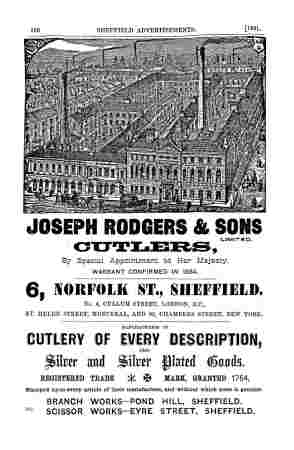
|
Page 198 of
Sheffield Advertisements,
illustrating
Joseph Rodgers &
Sons Limited
Cutlers
by Special
Appontment of Her
Majesty.
Warrant Confirmed in
1894
6, Norfolk St.,
Sheffield
This
famous firm of cutlers
and silversmiths was
founded in 1682 and
converted into a limited
liability company under
the style Joseph Rodgers
& Sons Ltd in 1871.
Besides their factory at
6 Norfolk Street,
Sheffield, the firm had
showrooms at 60 London
Viaduct, London and
three large factories
with over 2000 employees
(1901). Originally
makers of pen and
pocket-knives the firm
extended its business
including every variety
of cutlery, silver and
electro-plated items.
The firm was represented
in the Great Exhibition
of 1851, the
International Exhibition
of 1862 and the
Manchester Exhibition of
1887.
|
"A
WORD per MONTH"
In
this column we presents an
abstract from a page of the "What
is? Silver Dictionary"
courtesy of

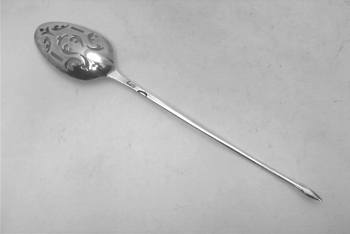
|
MOTE SPOON
MOTE SKIMMER
The silver mote
spoon (silver mote
skimmer) is a type of
spoon having a bowl with
a pierced pattern of
small holes, used to
skim off floating
particles of tea leaves
and motes (tea dust)
from a cup of tea. The
handle is thin and
tapering, with a
sharpened point.........
more
|
"A
BOOK ON MY SHELF"
In
this column we present books,
new or ancient, dealing with
silver in all its aspects (history,
marks, oddities...). This isn't
a "book review" but only a fair
presentation of some useful "tools"
that anyone may have in the
shelf of his bookcase.
ASCAS members are invited to
contribute to this column
(click to enlarge images)
The "book on my shelf" of
this month presents:
OLD COUNTRY SILVER
by Margaret Holland
David & Charles: Newton
Abbot
1971
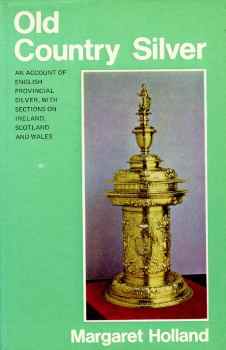 |
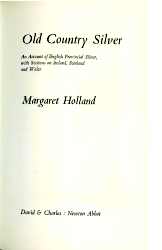 |
A commentator wrote
about this book: The
first to deal
exclusively with silver
made in all parts of the
British Isles other than
London, this book traces
the history of the
provincial silver-making
from the early times. It
describes silver stamped
in every corner of the
realm, with and
sometimes without the
sanction of the king or
parliament. It shows how
and why certain similar
objects were often made
differently and explains
why forms and styles
frequently varied from
region to region, and
how to recognise such
characteristics.
|
Closing
our MARCH 2009 edition of ASCAS
Newsletter I hope you have
appreciated its content.
Your comments, suggestions and
advice will be of great help.
My thanks
to Dorothea Burstyn, Charles C.
Cage, Giovanni Ciceri, Jayne Dye,
Mario Galasso, Kari Helenius,
David N. Nikogosyan, Adam
Thomson for their invaluable
contributions.
Giorgio Busetto
Secretary
DISCLAIMER AND PRIVACY
POLICY
ASCAS is a community
of people having a
common interest in
antique silver.
It is a non-profit
association without
commercial links.
Membership is open to
whomever has a true
interest in this subject
matter.
ASCAS has no real
property and no fees are
requested nor accepted
from members.
ASCAS keeps in touch
with its members only
through periodical
newsletters, e-mails and
web-site updating and
ignores and is not
responsible for any
other activity pursued
by its members.
Likewise, ASCAS is not
responsible for opinions,
evaluation and images
displayed, and in any
form published or
supplied for publication,
by its members who, in
any case, maintain the
property of their works
and assure the respect
of national and
international
legislation about
Intellectual Property.
ASCAS does not have the
full addresses of its
members (only town,
country and e-mail
address are requested
for membership).
ASCAS handles and
protects with care its
members e-mail addresses,
will not disclose the
addresses to third
parties, will use this
information only to
reply to requests
received from members
and for communications
strictly related to its
activity.
These rules are
expressly accepted by
submitting the
membership request.
|
|
|
|
|
|
|
|
|
 newsletter # 58 - MARCH 2009
newsletter # 58 - MARCH 2009



